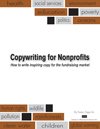Although my complete list of common mistakes in fundraising copy is much longer, these five mistakes top the list.
All types and sizes of organizations are guilty: Large and small, charities and associations alike. Yes, far too many nonprofits consistently write copy filled with these mistakes.

Top 5 mistakes in fundraising copy result in a "failing grade"
Countdown of the top 5 mistakes in fundraising copy:
5) Assume a level of knowledge and familiarity that just isn’t there.
Write your copy for absent-minded acquaintances who forget most of what you tell them. Even if a donor has been with you for 3 – 5 years, they’ll know a tiny fraction of what you do.
Your mission is not their life. They’re just compassionate enough to help someone else have a better life and your nonprofit is the instrument they choose to use.
Find more clarity on how to correct this mistake in another blog post, “We really don’t know you.”
4) Every letter or email tries to cover everything you do.
Even in acquisition you don’t HAVE to discuss every single program your charity provides. You don’t HAVE to write about ALL the ways you help people. And associations don’t HAVE to go into detail about every single member benefit.
Choose one program and gin up an appeal that’s emotion-charged and hard-hitting (I don’t mean “angry”; I mean compelling and not watered down with political correctness). And cover the story in depth so readers can make an emotional connection.
More on this common fundraising copy mistake, “Follow the Straight and Narrow”
3) Fail to show how a donor makes a difference.
Donors absolutely and positively WANT TO KNOW how they can make a difference by donating to your cause. And you must do this in terms they understand. I’ve got several blog posts on this topic including, “Acme Charity does great work. Give us money.”
For associations – show how the member’s life will be different after joining.
Here are more guidelines on how to avoid this mistake, “Raise money with appeal letters that are appealing”
2) Fundraising appeal written by committee.
With every additional person who reads and edits your appeal, the copy gets weaker.
This means you are deliberately slashing response and reducing the amount of revenue you raise. I don’t understand why nonprofits do business that way. Isn’t that self-destructive?
A popular post on this topic is, “Quickest Way to KILL Response”
In addition, copy written by committee fails to be authentic. Instead you need to “Tell It Like It Is”
1) Copy is NOT donor-centric. It doesn’t put the reader in the hero’s spotlight.
Your charity didn’t repeatedly fly Sam from his farm in rural Idaho to a hospital 253 miles away for cancer treatment. Your university didn’t give a $2,000 scholarship so Terry could finish her engineering degree.
Your donors did all that and more. Write about what your donors have done and can accomplish in the future by giving. It’s NOT about you or your nonprofit.
And yes, this is another topic I frequently write about. For example:
“Copy that your donors and members like”
How to Write Donor-Centric Tweets … examples
What are the top one, two or three mistakes you see in fundraising copy? Do you agree with my top five or do you have another to add? Please share in the comment box below.
Want even more info on this subject? Related posts are:
Sameness is the death of nonprofit copy
Don’t encourage donors to choose another nonprofit to support instead of yours
Giving once. Giving twice. SOLD! To the charity with the right message

{ 3 trackbacks }
{ 8 comments… read them below or add one }
Great post Karen. As a fellow fundraising copywriter I agree wholeheartedly with everything you’ve said here, and like you would also have a longer list!
I’d augment No. 2 slightly to – “Appeal written by committee – or written by a professional, then destroyed by a committee.” (Been there too many times).
I’d also want to find room for: “Talking to donors about features instead of benefits.” Also known in the commercial sector as “Trying to sell the steak, instead of the sizzle”.
It seems to be endemic in the non-profit sector that charities believe their donors are interested in the internal machinery of how their organization works, when really what donors want to hear about is how their support fuels the magic of changing and saving lives. Successful appeals “sell the magic, not the machinery.”
Anyway, I really enjoyed your post. I might blog about this as well, with naturally a credit for the source! Thanks.
Hi Jules,
Thanks so much for your kind words. And I too have had letters I’ve written destroyed by committee. (Sigh)
Next item: Although many folks working at the nonprofit org don’t like to think of it this way, fundraising appeals are selling. We’re selling a cause and that’s why the focus needs to be on the donors. WIIFM? [What’s In It For Them?] Donor-centric copy.
This goes to your comment on selling benefits and not features. Good point.
We really need more resources for online fundraising methods and techniques. It help us and our cause.
I love the part about explaining your mission to them, who you are, and I do that. But confess I am guilty of saying too much in the letter about all our programs and now will alter my approach. But the thing I really dislike in the letters I receive is the overuse of bolding and underlining. It is ugly, it feels aggressive and does not make me want to finish reading the letter. Use it once to highlight a point, then leave the rest of your appeal alone – more than three parts bolded and highlighted and I pitch the letter without reading it.
Great column.
Meghan
Hi Meghan,
Cutting back and keeping a narrow focus (i.e., fewer topics) can be difficult. You feel the reader just has to know this and that and oh … this other think too. However, it helps people learn more about each topic because you can cover it in more depth. And you’ll discover who responds to what. Then you can segment your file and give readers / donors more of what they like best which should help response.
With regard to bolding and underlining: The right amount helps the skimmers get the gist of the letter, and keeps all readers focused. If you’re writing copy I urge you to NOT be guided by your personal dislike of bolding and underlining. Yes it can be overdone. But how much is the right amount varies from letter to letter, and with the length of the letter.
What you and I personally like in a letter doesn’t matter. What does matter is how it performs in the mail. Testing and results should guide how letters are written. Go with what yields the desired results whether you like it or not. That can be challenging to do but it “pays” off.
Thanks for your comments and I’m glad you like my blog!
Sagolsem,
Glad you find my blog a helpful online resource. If you have a specific question I invite you to visit the “CONTACT” page of this website and send me an email. If it falls within my area of expertise I’ll write a future blog post about it. Thank you.
We must say … nice work. Keep up with your good work on the blog; we always look forward to it.
Thanks, Tom.
I looked over your website and liked what I saw. Quality evergreen products for the Christmas season and a friendly system for helping groups raise funds. You do have a good “fundraising event idea” or rather … it’s a solid system backed by a company that’s been around since the 1960’s.